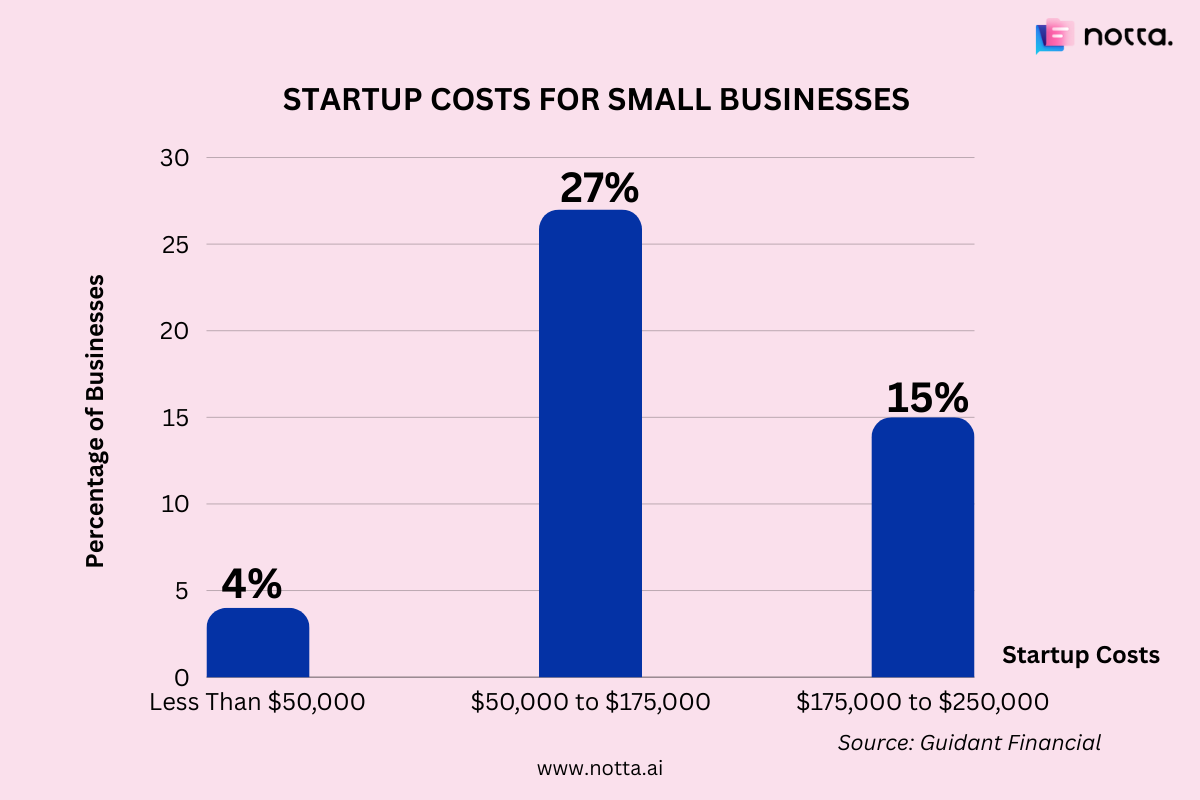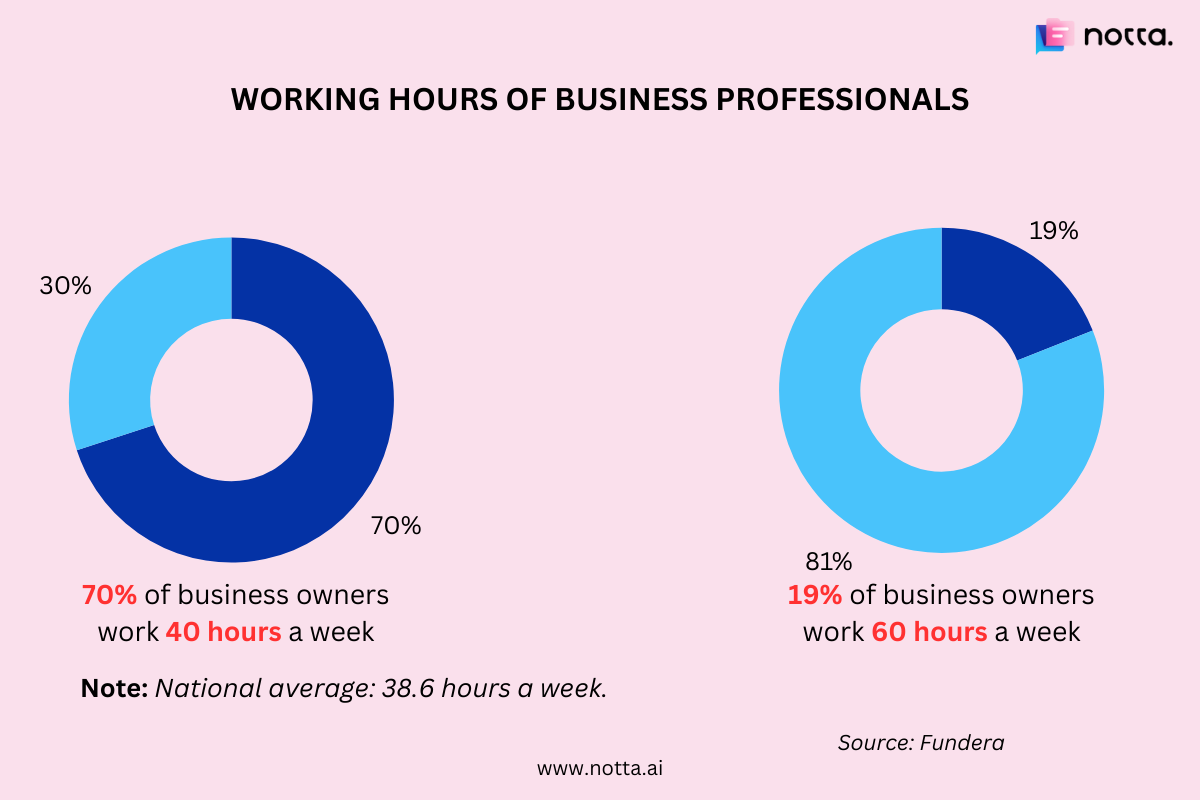
50+ Must-Know Small Business Statistics & Facts for 2025
Record, transcribe and summarize conversations with one click.
While large corporations tend to gain the most visibility around us, small businesses often form the backbone of most large economies. Understanding the small business landscape is critical for entrepreneurs in order to analyze the way in which the tides are shifting.
It also helps them identify the emergence of new opportunities and how they can leverage them to remain one step ahead of the competition.
Statistics offer a wealth of information in this regard, and this guide explores 50+ small business statistics that you must know. All the statistics have been categorized to make the guide easy for you to understand.
Why statistics are important to small business
Statistics offer a wide range of benefits to small businesses. It helps business owners get an overview of their respective industries and the economy while also offering granular insights into key aspects of running a business. Here are a few key benefits:
Helps in decision-making: A decision is only as sound as the information used to make it, and reliable statistics can help business owners make well-informed choices.
Understanding operating costs: Statistics also help small business owners understand the operating costs and the revenue their business can potentially generate within the context of the industry they operate in.
Overview of employee productivity
Before we dive into the key statistics about small businesses, here is a quick summary and a few key findings:
99.9% of all American businesses are small businesses. This shows the degree of opportunities present for individuals to enter the small business economy.
Small businesses in the US have contributed to 70% of net job increases.
Startup costs for small businesses range from less than $50,000 to more than $1,000,000.
Small businesses have generated a whopping 12.9 million jobs in the past 25 years.
More than 70% of small business owners stated they work for more than 40 hours a week, and 19% stated working more than 60 hours a week, with a national average of 38.6 hours per week as of 2020.
54% of all businesses use social media to generate leads.
23% of small business owners stated that 5G planning and adoption was a top priority for sales, marketing, and business development leaders, and 19% stated that it was a top priority for strategy and operations leaders.
General small business statistics
To start, I'll take you through some of the general small business statistics that help paint a picture of what the market looks like, the key trends, and provide other valuable information.
99.9% of all American businesses are small businesses. This shows the degree of opportunities present for individuals to enter the small business economy.
The US has over 34 million small businesses. As the previous statistic demonstrated, this number constitutes most of the businesses in the country, showing how friendly the economy is to small businesses.
The US has received a whopping 16 million applications for small businesses since 2021. The effects of the COVID-19 pandemic have fueled an uptick in the number of individuals starting up on their own
Small businesses in the US generate 34.9% of all known export value. This demonstrates their immense value to the US’ export revenue.
Small businesses employ 59 million Americans as of 2024. These numbers equate to 45.9% of all private-sector employees in the country.
Two of the primary reasons why business owners decide to start their own businesses are that they’re ‘ready to be their own boss’ (28%) and their overall dissatisfaction with America’s corporate landscape (23%).
The majority of small business owners are made up of Baby Boomers (39.63%) and Gen X (47.20%).
Small business growth statistics
Understanding trends in the growth of small businesses can help potential new business owners identify challenges and opportunities in the market. This section lists some key small business growth statistics for your reference.
5 out of 20 of the fastest-growing industries are in the healthcare and social assistance sectors. Employment in these industries is projected to grow from 162.8 million to 168.8 million in the decade between 2019-2029. This will account for an increase in 6 million jobs.
Those in traditional face-to-face business setups like retail, food & beverage, and restaurants and bars are more worried about fulfilling their inventory and bouncing back to their pre-COVID levels, especially with an increasingly cost-conscious public.
25% of SBA microloans from its microloan program went to startups in the fiscal year 2023. Some of the key factors that influence someone’s eligibility for these loans are what the business does to receive its income, its credit history, and where the business operates.
The retail sector was the biggest driver of growth in terms of business applications, with 524,803 applications in 2019 up to 983,464 in 2021.
Some sectors recovered to pre-pandemic levels, with the Transportation and Warehousing sector witnessing a 9.7% increase in establishments and a 9.5% increase in employment between March 2020 and March 2022.
Small businesses in the US have contributed to 70% of net job increases. While the pandemic led to 8.6 million jobs being lost by the second quarter of 2020, the financial year 2021-2022 saw 4.9 million jobs being created, which accounted for 70% of all new jobs during the period.
Small business financing statistics
Understanding how small businesses are financed and the key trends in finance can help small business owners understand how they can get the support they need to get their businesses up and running. This section lists some of the small business revenue statistics for you to understand this aspect in greater detail.
Startup costs for small businesses range from less than $50,000 to more than $1,000,000. While 4% managed to start their businesses with less than $50,000, 27% reported their startup costs between $50,000 to $175,000, and 15% said that their startup costs fell between $175,000 to $250,000.

About half of small business owners use 401(k) business financing to kickstart their new ventures. Others rely on cash, SBA loans, lines of credit, and terms and unsecured loans.
The average base salary of a small business owner is $70,781 per year.
60% of small businesses have less than $50,000 in debt in 2020. On the other end of the spectrum, 4% reported having a debt of between $500,000 to $999,999, while 6% reported a debt of at least $1,000,000.
Over 50% of small businesses state that their primary challenge is inflation.
The global average closure rate for SMBs is 19%, which is a small decrease from the 20% recorded in Jan 2022.
The fiscal year 2023 saw a total of 57,362 SBA 7(a) loans amounting to $27.5 billion being provided to small businesses. The 7(a) is the SBA’s primary loan program that aims to offer small businesses with special needs the financial assistance they need.
Small business success vs. failure statistics
Statistics about the success or failure of small businesses paint an accurate picture for those in the early stages of considering setting up their enterprises. This section lists a few key statistics that can help.
44% of small businesses reported witnessing an increase in their revenues in 2022. 18% recorded no change in revenue. About 80% of small businesses survive their first year in business, demonstrating a high small business success rate. Added to this is that about 50% remain open and running over a period of five years.
The percentage of small businesses with a large negative impact as a result of the COVID-19 pandemic reduced from 51.4% in April 2020 to 21.6% in April 2022.
In 2020, about 1.07 business establishments opened for the first time, whereas 1.02 million closed permanently.
In the year 2021, about 27% of small businesses reported being family-owned, whereas 73% were not.
82% of small businesses fail due to poor cash flow management. This is often the result of using more traditional strategies to manage cash flow. Some other key challenges include the potential for human error in data entry and calculations.
Small business employment and workforce statistics
Understanding employment patterns in small businesses can provide deeper insights into how they’re run, how many employees they have, and other valuable information. This section lists some of the key statistics about employment and workforce in small businesses.
Small businesses have generated a whopping 12.9 million jobs in the past 25 years.
Since the first quarter of 2021, small businesses have accounted for about 53% of all 12.2 million jobs created across all firm sizes.
Black business owners own about 3.5 million businesses and employ over 1.2 million people. They generate a total of 217.3 billion in sales.
Small businesses comprise 99.7% of all firms with paid employees.
12.07 million small businesses in the US are owned by women, 1.49 million are equally by men and women, 2.66 million are owned by Asians, and 4.24 million are owned by those of Hispanic origin.
As of 2019, veterans owned about 331,151 employer firms, which accounted for 6% of all US employer firms. As of 2018, veterans also owned about 1.4 million nonemployer firms, which accounted for 5.4% of all nonemployer firms.
As of 2019, immigrants owned about 18% of all employer firms. The industries that have the greatest share of immigrant owners are those of accommodation and food services at 37% and retail trade at 24%.
More than 70% of small business owners stated they work for more than 40 hours a week, and 19% stated working more than 60 hours a week, with a national average of 38.6 hours per week as of 2020.

Over 70% of business owners feel satisfied as business owners, while 37% feel ‘very happy’ and 35% feel ‘somewhat happy.’
Want the convenience of automated note-taking and AI summaries? Try Notta for your upcoming meetings.
Small business technology statistics
Technology has become an integral aspect of running small businesses. Whether you use it to manage customer relationships, organize your payroll, or market your products and services, it can significantly streamline your business operations if used correctly.
As of 2018, the total number of employer firms that used specialized software stood at 1.8 million, which made up about 38.3% of all employer firms. In terms of gender, 38.9% of male-owned firms and 38.4% of female-owned firms made use of specialized software to run their businesses.
In 2018, the number of employer firms that made use of cloud computing stood at 1.6 million, which accounts for 32.4% of all employer firms. In terms of gender, 32.6% of male-owned firms and 33.9% of female-owned firms made use of cloud-based software in some aspect of their business.
95% of small businesses in 2023 use at least one technology platform, which is up from the 93% recorded in the year 2022. There are plenty of SaaS tools for small businesses that can help scale operations too.
Social media and digital payment platforms are the most used among small businesses in the US. 87% of businesses use social media, whereas 41% use point-of-sales tools, and these saw the greatest increase year over year from 2021 to 2022.
51% of small businesses have either added or upgraded their internet connections to a high-speed or high-capacity plan.
One in four small businesses have reported making use of artificial intelligence tools (AI).
Small businesses that have adopted the use of AI witness an increase of 12 points in their likelihood of increasing their profits. This is in comparison to those that are yet to adopt the use of AI in their operations.
82% of small businesses are optimistic that technology will benefit their businesses in the future, and 85% plan on increasing their use of technology platforms.
7 out of 10 business owners would like to see the use of modernized IT processes to improve the ease of doing business with the government.
In terms of how small businesses use technology, 61% in 2023 used it for marketing and promotions, 54% used it for payroll management, and 52% used it to manage customer relationships.
23% of small business owners stated that 5G planning and adoption was a top priority for sales, marketing, and business development leaders, and 19% stated that it was a top priority for strategy and operations leaders.
50% of small business owners stated that their employees don’t receive any cybersecurity training. This increases the risk small businesses face to cyberattacks, most of which have a financial motive.
54% of all businesses use social media to generate leads. This makes it the most popular channel for lead generation. Referrals, in turn, account for about 50%, whereas paid advertising accounts for about 45% of business lead generation.
The top lead generation channels vary from one industry to another. For the accounting industry, the top three channels for lead generation are paid advertising, social media, and paid search, whereas those for digital marketing are social media, paid advertising, and referrals.
45% of businesses have recognized the need to improve their processes in 2024. These preferences are spread across different operations, such as improving business processes at roughly 45%, leveraging AI at almost 40%, forging partnerships at about 35%, and making greater use of software at just above 30%. Forging partnerships often requires writing crisp business proposals and streamlining internal processes.
The bottom line
Small businesses are on the rise in the US, and while the effects of the COVID-19 pandemic are yet to entirely be erased, businesses across sectors have made remarkable comebacks in more ways than one. This fact is evidenced by several small business statistics listed in this guide. They have realized the importance of using technology like AI to improve their business processes and achieve greater employee productivity on their bottom line.
One of the key aspects of a business’s growth is how they streamline their operations and boost productivity. With the widespread availability of AI tools today, businesses can automate their processes and focus their resources on more profitable operations. Tools like Notta, for example, can streamline meetings at the workplace by automatically transcribing, recording, and summarizing them to ensure higher ROI and employee productivity.
References
Slack - The State of Work 2023
McKinsey - Some employees are destroying value. Others are building it. Do you know the difference?
US Small Business Administration - Frequently Asked Questions About Small Businesses, 2024
US Small Business Administration - New Business Applications Reach Record 16 Million Under Biden-Harris Administration
Guidant Financial - 2024 Small Business Trends
Payscale - Average Small Business Owner Salary
US Small Business Administration - 2023 Small Business Profile
US Small Business Administration - 7(a) and 504 Lender Report
US Bureau of Labor Statistics - TED: The Economics Daily
Verizon - Verizon Business’ 3rd Annual State of Small Businesses Survey
Black-Ownership SUS Small Business Administration - Microloans Summary Report
US Small Business Administration - Business Dynamics During the COVID-19 Pandemic
Board of Governors of the Federal Reserve System - Availability of Credit to Small Businesses
FED Small Business: 2023 Report on Employer Firms: Findings from the 2022 Small Business Credit Survey
US Bureau of Labor Statistics - Table 7. Survival of Private Sector Establishments by Opening Year
US Small Business Administration - Frequently Asked Questions, March 2023
Pew Research Center - A Look at Small Businesses in the US
The National Federation of Independent Businesses - Why Do Small Businesses Fail?
US Small Business Administration - Small Business Facts: Small Business Job Creation
US Small Business Administration - Facts About Small Businesses: Black Business Ownership 2024s
Us Chamber of Commerce Technology Engagement Center - The Impact of Technology on U.S. Small Business
BullGuard - BullGuard Small Office Security Survey Press Kit